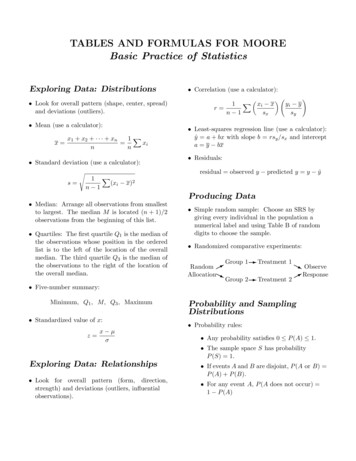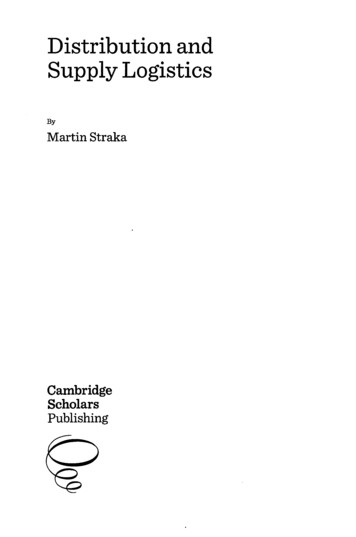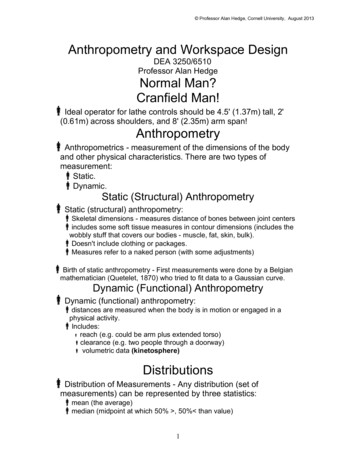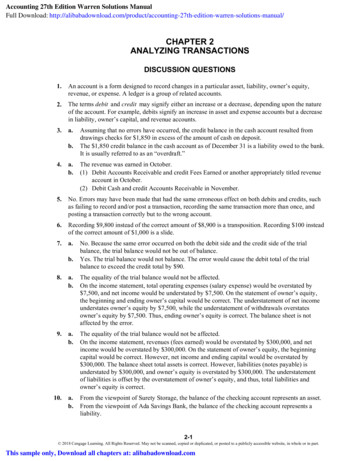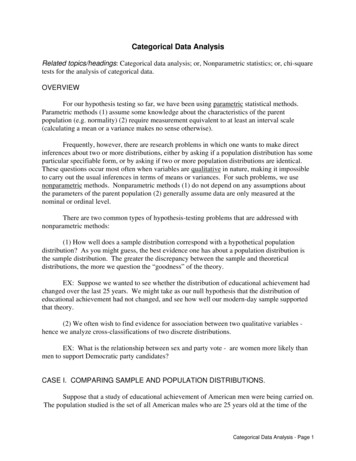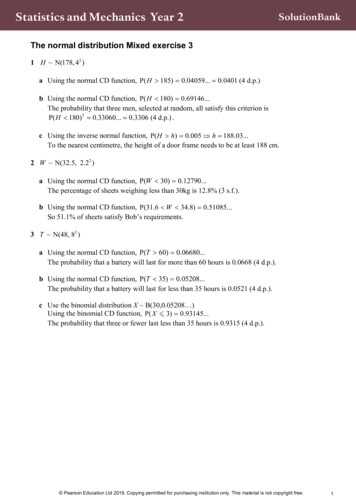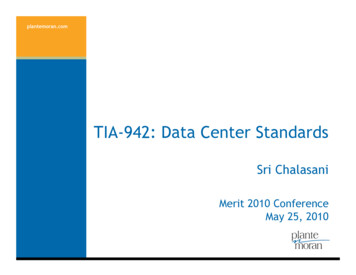
Transcription
The Normal DistributionDiana Mindrila, Ph.D.Phoebe Baletnyne, M.Ed.Based on Chapter 3 of The Basic Practice of Statistics (6th ed.)Concepts: Density Curves Normal Distributions The 68-95-99.7 Rule The Standard Normal Distribution Finding Normal Proportions Using the Standard Normal Table Finding a Value When Given a ProportionObjectives: Define and describe density curves Measure position using percentiles Measure position using z-scores Describe Normal distributions Describe and apply the 68-95-99.7 Rule Describe the standard Normal distribution Perform Normal calculationsReferences:Moore, D. S., Notz, W. I, & Flinger, M. A. (2013). The basic practice of statistics (6thed.). New York, NY: W. H. Freeman and Company.
Density CurvesExploring Quantitative Data1. Always plot data first: make a graph.2. Look for the overall pattern (shape, center, and spread) andfor striking departures such as outliers.3. Calculate a numerical summary to briefly describe center andspread.4. Sometimes the overall pattern of a large number ofobservations is so regular that it can be described by a smoothcurve. When describing data, always start with a graphical representation.Graphs help identify the overall distribution pattern. Looking at a graphmakes it visually clear how spread a variable is, which values occur mostfrequently, and whether or not the distribution is skewed.Next, obtain more precise information by providing a numerical summary ofthe data using the mean, median, range, five-number summary, and anyother appropriate information.Some distributions are so regular that they can be described by a smoothcurve. Real data are represented in a histogram. Curves represent a symbol,or an abstract version of a distribution.A density curve is a curve that: is always on or above the horizontal axis has an area of exactly 1 underneath itA density curve describes the overall pattern of a distribution. The area underthe curve and above any range of values on the horizontal axis is the proportionof all observations that fall in that range. Density curves are lines that show the location of the individuals along thehorizontal axis and within the range of possible values.They help researchers to investigate the distribution of a variable.Some density curves have certain properties that help researchers drawconclusions about the entire population.
Density Curves Measures of center and spread apply to density curves as well as to actualsets of observations.Distinguishing the Median and Mean of a Density Curve The median of a density curve is the equal-areas point, the point thatdivides the area under the curve in half.The mean of a density curve is the balance point, at which the curvewould balance if made of solid material.The median and the mean are the same for a symmetric density curve.They both lie at the center of the curve. The mean of a skewed curve is The mean, median, and mode can also be represented on density curves.When a distribution is symmetric or Normal, the mean and median overlap.The actual recorded values may be slightly different, but they are very close.The mode will always be located at the highest point on the curve, because itshows the vale that occurs most frequently.The median shows the point that divides the area under the curve in half,whereas the mean, which is drawn toward the extreme observations, showsthe balance point.
Density Curves The mean and standard deviation computed from actual observations (data)are denoted by 𝑥̅ and s, respectively The mean and standard deviation of the actual distribution represented bythe density curve are denoted by 𝜇 (“mu”) and 𝜎 (“sigma”), respectively. The mean and standard deviation (𝑥̅ and s) are called statistics, andthey can be computed based on observations in the sample. The mean and standard deviation of the density curves (𝜇 and 𝜎) arecalled parameters. They describe the entire population and are onlyestimated. With very few exceptions, the real value of the populationis unknown and the values must be estimated, with a certain degree ofconfidence, based on observations from the sample.
Normal Distributions One particularly important class of density curves are the Normal curves,which describe Normal distributions. All Normal curves are symmetric, single-peaked, and bell-shaped. A Specific Normal curve is described by giving its mean 𝜇 and standarddeviation 𝜎. Density curves are used to illustrate many types of distributions.The Normal distribution, or the bell-shaped distribution, is of special interest.This distribution describes many human traits. All Normal curves havesymmetry, but not all symmetric distributions are Normal.Normal distributions are typically described by reporting the mean, whichshows where the center is located, and the standard deviation, which showsthe spread of the curve, or the distance from the mean. When the standard deviation is large, the curve is wider like theexample on the left. When the standard deviation is small, the curve is narrower like theexample on the right.One example of a variable that has a Normal distribution is IQ. In thepopulation, the mean IQ is 100 and it standard deviation, depending on thetest, is 15 or 16. If a large enough random sample is selected, the IQdistribution of the sample will resemble the Normal curve. The large thesample, the more clear the pattern will be.
Normal Distributions A Normal distribution is described by a Normal density curve. Anyparticular Normal distribution is completely specified by two numbers: itsmean 𝜇 and its standard deviation 𝜎. The mean of a Normal distribution is the center of the symmetricNormal curve. The standard deviation is the distance from the center to the changeof-curvature points on either side. The Normal distribution is abbreviated with mean 𝜇 and standarddeviation 𝜎 as 𝑁(𝜇, 𝜎)
Normal CurveExample: IQ scoredistribution based onthe Standford-BinetIntelligence ScaleThe smooth curvedrawn over thehistogram is amathematical modelfor the distribution. The histogram in this image represents a distribution of real IQ scores asmeasured by the Standford-Binet Intelligence Scale.The blue bars represent the number of individuals who recorded IQ scoreswithin a certain 5-point range.The main purpose of a histogram is to illustrate the general distribution of aset of data.This variable has a mean of 100 and a standard deviation of 15.The curve that is drawn over the histogram is the Normal curve, and itsummarized the distribution of the recorded scores.
Normal CurveThe areas of the shaded bars inthis histogram represent theproportion of scores in theobserved data that are lessthan or equal to 90.Total: N 1015IQ 90: N 256 (25.22%)Now the area under thesmooth curve to the left of 90 isshaded. If the scale is adjustedso the total area under thecurve is exactly 1, then thiscurve is called a density curve.Total Area 1Shaded Area 0.2546 The entire area under the curve represents all the individuals in the sample.If only part of the area is shaded, this represents the proportion ofindividuals who scored below a certain point.In this above example, the area under the curve represents all the individualsin the sample. In this case, they add up to 1,015. This number represents100% of the sample.The shaded area in the above example represents the individuals who had anIQ score below 90. This group consists of 256 individuals.To find the percentage, divide the number in the group by the total number,and then multiply by 100. In this case, 256 divided by 1015 times 100 resultsin a percentage of 25.22. This means that 25.22% of the individuals in thissample had an IQ score below 90.The Normal curve is used to find proportions from the entire population,rather than just from the sample. The values for the entire population areoften unknown, but if the variable has a Normal distribution, the proportioncan be found using only the population mean and standard deviation for thatvariable.Rather than using percentages, statisticians use decimals. Therefore, theentire area under the curve is 1. Using the properties of the Normal curve,the shaded are in the above example is 0.2546. This will be explained ingreater detail later.
The 68-95-99.7 RuleThe 68-95-99.7 RuleIn the Normal distribution with mean µ and standard deviation σ: Approximately 68% of the observations fall within σ of µ. Approximately 95% of the observations fall within 2σ of µ. Approximately 99.7% of the observations fall within 3σ of µ. Normal curves enable researchers to calculate the proportions of individualswho are located within certain intervals. With Normal curves, some intervalsare already calculated. This is called the 68-95-99.7 Rule.If the population mean and standard deviation for a particular variable areknown, the location of the majority of individuals can be quickly found.The majority of individuals are located in the highest area of the curve, whichis around the mean.The intervals within one standard deviation of the mean each account for34.1% of the population.Therefore, approximately 68% of the population is located within onestandard deviation above or below the mean.The intervals between one and two standard deviations away from the meanin either direction each account for 13.6% of the population.Therefore, after adding the percentages in all four intervals, approximately95% of the population is located within two standard deviations above orbelow the mean.The intervals between two and three standard deviations away from themean in either direction each account for 2.1% of the population.Therefore, approximately 99.7% of the population is located within threestandard deviations from the mean.
Technically, the two tails of the Normal curve extent to positive or negativeinfinity, but these numbers would be limited for certain variables like IQ,which cannot be smaller than zero.The proportion of individuals who are located more than three standarddeviations above or below the mean is extremely small: only 0.3%.
The 68-95-99.7 Rule Example Figure 1 illustrates how to apply the 68-95-99.7 Rule to the distribution of IQscores.In this example, the population mean is 100 and the standard deviation is 15.Based on the 68-95-99.7 Rule, approximately 68% of the individuals in thepopulation have an IQ between 85 and 115. Values in this particular intervalare the most frequent.Approximately 95% of the population has IQ scores between 70 and 130.Approximately 99.7% of the population has IQ scores between 55 and 145.Only approximately 0.3% of the population has IQ scores outside of thisinterval (less than 55 or higher than 145).
The Standard Normal Distribution All Normal distributions are the same if they are measured in units of size 𝜎from the mean 𝜇 as center.The standard Normal distribution is the Normal distribution withmean 0 and standard deviation 1.If a variable x has any Normal distribution N(µ,σ) with mean µ andstandard deviation σ, then the standardized variablehas the standard Normal distribution, N(0,1). The Normal curve can be used to describe the distribution of many variables.Sometimes researchers want to compare scores that have been measured ondifferent scales. Comparisons are meaningless if scores are not on the samescale. Therefore, to be able to make comparisons across variables, variablesthat have a Normal distribution can be standardized, which simply meansthat they are put onto the same scale.There are many types of standardized scales. One type of standardized scorethat researchers use frequently is z scores.Z scores are used with variables that have a Normal distribution. Z scoreschange the values so that the distribution has a mean of 0 and a standarddeviation of 1. In theory, z scores can range from negative infinity to positiveinfinity.Z scores can be calculated for every individual in the data set using a simpleformula:1) Compute the difference between the individual’s score and thepopulation mean.2) Divide this difference by the standard deviation.If an individual’s score is lower than the mean, the z score will be negative. Ifthe individual’s score is higher than the mean, the z score will be positive.
Normal Distributions ExampleExample:Joe: IQ 111Sigma 15Pop. Mean 100Joe’s IQ on the zdistribution:z (111-100)/15z 11/15z 0.73 Mean 0Joe’s z score 0.73In this example, an individual score on a Normal distribution is given.The top image shows the IQ score distribution. The bottom image shows thecurve from this distribution transformed into z scores.To find the z score for Joe’s IQ:1) Subtract the mean from the score (score – mean) (111 – 100) 112) Divide the difference by the standard deviation 11/15 0.73Now that a z score has been obtained, it would be helpful to find out theproportion of individuals who have an IQ below 111, or a z score below 0.73.In other words, what is the area under the curve on the left side of thisspecific score?
The Standard Normal Table All Normal distributions are the same when they have been turned into zscores. Therefore, areas under any Normal curve can be found using a single table.The Standard Normal TableTable A is a table of areas under the standard Normal curve.The table entry for each value z is the area under the curve tothe left of z.To find the proportion of observationsfrom the standard Normal distributionthat are less than 0.73, use table 939.79670.70.8 .7580.7611.7642P (z 0.73) .7673.7673For every z score, areas on the left side of the curve have already beencomputed and are listed in a probability table. Statistics textbooks generallystore these tables in the appendices.This table lists the first two digits of the z score vertically and the last digithorizontally.In this example, to find the area under the curve for a z score of 0.73, start byfinding 0.7 on the left. Then find 0.03 at the top. Finally, find the cell wherethis row and column meet. The value in this cell (0.7673) is the area underthe curve for a z score of 0.73.This value means the probability of a z score being lower than this one is0.7673.Simply put, 76.73% of the population has a z score at or below 0.73.In this case, 76.73% of the population has an IQ equal to or lower than 111.
Normal Calculations The Normal curve can be used to compute proportions, not only from onestandard deviation to another, but also for specific values of interest.Joe: IQ 111, z 0.73Matt: IQ 85, z – 1 Example: Find the proportion of observations from the standard Normaldistribution that are between IQ 85 and IQ 111.1) Find the probability of having an IQ score that is 111 (Joe’s score) orlower. Transform Joe’s score (111) into a z score (z 0.73) Use the z score table to find the area to the left of this score (0.7673) The probability of having an IQ score that is 111 or lower isapproximately 77%2) Find the probability of having a score that is 85 (Matt’s score) or lower. Transform Matt’s score (85) into a z score (z – 1) Use the z score table to find the area to the left of this score (0.1587) The probability of having an IQ score that is 85 or lower isapproximately 16%3) Find the percentage of the population that has IQ scores between 85 and111. Take the probability of having an IQ score that is 111 or lower andsubtract the probability of having an IQ score that is 85 or lower tofind the probability of being in between these two scores. 77% – 16% 61% or 0.7673 – 0.1587 0.6086 Approximately 61% of individuals have IQ scores between 111 and 85To find the percentage of individuals who score above a certain z score,simply subtract the percentage to the left of that score from 100%. Example: Find the percentage of individuals with an IQ score higher than111 Find the percentage of individuals who score below 111 (77%) Subtract this percentage from 100% (100% – 77% 23%) Approximately 23% of individuals score above 111
Normal Distributions The Normal distribution is very useful for comparing variables that aremeasured on different scales. Example: a graduate student has a score of 25 on a quiz and a score of 56 onthe final exam. On which assessment did the student perform better? Thisdepends on the distribution of the two variables. If the quiz is out of 30 points and the exam is out of 100 points, it mayseem clear that the quiz performance was better. However, using the Normal curve, the most important information isthe mean and the standard deviation. Standardized scores (e.g. z scores) can help to compare scoresmeasured on different scales.Quizx1 25Mean 20St. Dev. 5Z1 (25-20)/5 5/5 1 Examx2 56Mean 68St. Dev. 12Z2 (56-68)/12 – 12/12 –1 After calculating the z scores for both assessments, it can beconcluded that this student performed better on the quiz, even thoughthe raw score of 25 was lower than the raw score of 56. The student’s performance on the quiz was one standard deviationabove the mean and the student’s performance on the exam was onestandard deviation below the mean, resulting in a higher performanceon the quiz.This example makes it clear that if it is necessary to compare scores that areon different scales, the scores must be standardized or put on the same scale.In this case, the standardized scores are z scores, but there are many otherkinds of standardized scores.If raw scores only are compared, the results can be misleading, as thisexample demonstrated.It is important to note that these comparisons are based on the assumptionthat the two variables have a Normal distribution in the population.
Normal CalculationsHow to Solve Problems Involving Normal DistributionsState: Express the problem in terms of the observed variable x.Plan: Draw a picture of the distribution and shade the area of interest under thecurve.Do: Perform calculations. Standardize x to restate the problem in terms of a standardNormal variable z.Use Table A and the fact that the total area under the curve is 1to find the required area under the standard Normal curve.Conclude: Write the conclusion in the context of the problem.
example on the left. When the standard deviation is small, the curve is narrower like the example on the right. One example of a variable that has a Normal distribution is IQ. In the population, the mean IQ is 100 and it standard deviation, depending on the test, is 15 or 16. If a large enough random sample is selected, the IQ



